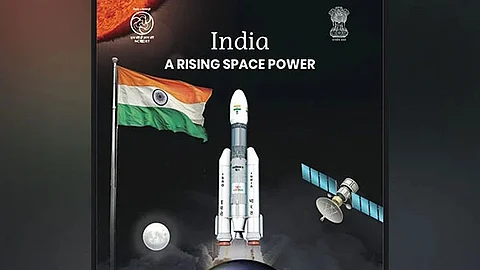
- News
- Campus
- Exam
- Podcast
- Web Stories
- Do You Know
- Path Finders - UG Programs
- Videos
- Élitscape

The National Council of Educational Research and Training (NCERT) has released special modules on India's space programme, tracing the country's rise from carrying rockets on bicycles and bullock carts in the 1960s to becoming one of the world's most cost-effective space powers with landmark missions such as Chandrayaan-3 and Aditya-L1.
The module, titled India: A Rising Space Power, is illustrated with images, infographics, and timelines to assist students grasp the country's space history.
It describes how the Indian National Committee for Space Research (INCOSPAR), founded in 1962 by Vikram Sarabhai, matured into the Indian Space Research Organisation (ISRO), which went on to achieve milestones that have elevated India to the ranks of premier spacefaring nations.
"Our missions are low-cost and simple but high-tech and robust designs; self-reliant in most of its space programmes; these are synergetic and focused," the module notes, summing up ISRO's approach to space exploration.
The two modules, one for middle-school students and the other for secondary students, honour India's astronauts, Squadron Leader Rakesh Sharma, who became the first Indian to travel to space on a Soviet mission in 1984, and Group Captain Shubhanshu Shukla, who became the first Indian to live and work aboard the International Space Station (ISS) in June 2025.
It remembers the launch of India's first satellite, Aryabhata, in 1975, as well as the Satellite Instructional Television Experiment (SITE), which delivered television to communities across India.
The early days are contrasted with modern achievements such as Chandrayaan-3's historic south pole landing in 2023, which made India the first nation to land in that part of the Moon.
The module lists several landmark missions, such as Chandrayaan-1, through which water molecules were discovered on the Moon; Mangalyaan (2013), which made India the first Asian country to reach Mars and the first in the world to succeed on its first attempt; Chandrayaan-2 (2019), whose orbiter continues to provide critical lunar data; and Aditya-L1 (2023), India's first solar observatory at Lagrange Point-1 that studies the Sun's outer atmosphere and solar storms.
It also talks about the upcoming NASA (National Aeronautics and Space Administration)-ISRO NISAR satellite, which will offer high-resolution data on Earth's ecosystems, ice cover, and natural disasters by surveying the world once every 12 days.
The textbook also highlights India's human spaceflight mission, Gaganyaan, which seeks to send a three-person crew into a 400 km low Earth orbit for three days.
It mentions future projects, such as Chandrayaan-4, a lunar sample return mission, and the Bharatiya Antariksh Station (BAS), which is set to be authorised in 2024 and would serve as India's own space station for long-duration missions and microgravity research.
The NCERT module also highlights the role of India's space applications in everyday life. "India's space programme is not just about exploration of planets and stars, but about improving lives on Earth through applications in weather forecasting, agriculture, education and health," it underlines.
